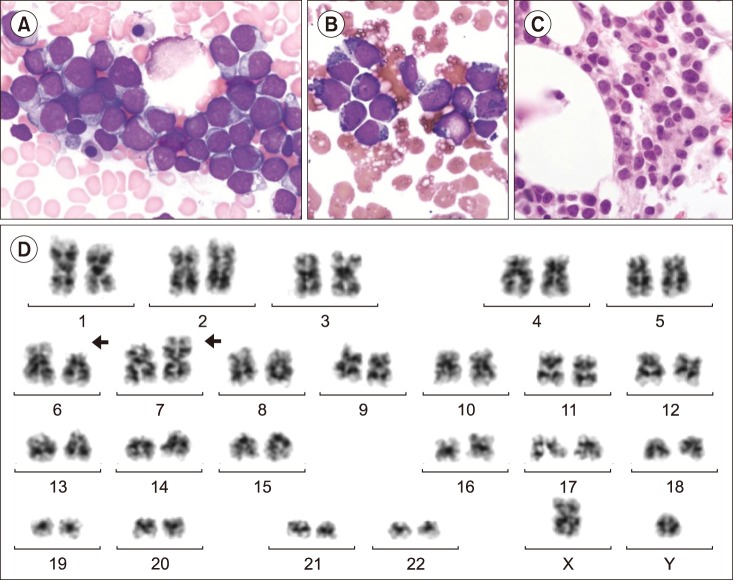Blood Res.
2016 Dec;51(4):279-281. 10.5045/br.2016.51.4.279.
The first case of acute myeloid leukemia with solitary t(6;7)(p21.3;p22) passenger translocation that developed at relapse after allogeneic hematopoietic stem cell transplantation in a patient with a normal karyotype at the initial diagnosis
- Affiliations
-
- 1Department of Laboratory Medicine, Pusan National University School of Medicine, Pusan National University Hospital, Busan, Korea. korailman-1@hanmail.net
- 2Biomedical Research Institute, Pusan National University School of Medicine, Pusan National University Hospital, Busan, Korea.
- 3Division of Hematology-Oncology, Department of Internal Medicine, Pusan National University School of Medicine, Pusan National University Hospital, Busan, Korea.
- KMID: 2364320
- DOI: http://doi.org/10.5045/br.2016.51.4.279
Abstract
- No abstract available.
MeSH Terms
Figure
Reference
-
1. Zagaria A, Anelli L, Coccaro N, et al. 5'RUNX1-3'USP42 chimeric gene in acute myeloid leukemia can occur through an insertion mechanism rather than translocation and may be mediated by genomic segmental duplications. Mol Cytogenet. 2014; 7:66. PMID: 25298786.
Article2. Masetti R, Togni M, Astolfi A, et al. Whole transcriptome sequencing of a paediatric case of de novo acute myeloid leukaemia with del(5q) reveals RUNX1-USP42 and PRDM16-SKI fusion transcripts. Br J Haematol. 2014; 166:449–452. PMID: 24673627.3. Ji J, Loo E, Pullarkat S, Yang L, Tirado CA. Acute myeloid leukemia with t(7;21)(p22;q22) and 5q deletion: a case report and literature review. Exp Hematol Oncol. 2014; 3:8. PMID: 24646765.
Article4. Panagopoulos I, Gorunova L, Brandal P, Garnes M, Tierens A, Heim S. Myeloid leukemia with t(7;21)(p22;q22) and 5q deletion. Oncol Rep. 2013; 30:1549–1552. PMID: 23877199.
Article5. Jeandidier E, Gervais C, Radford-Weiss I, et al. A cytogenetic study of 397 consecutive acute myeloid leukemia cases identified three with a t(7;21) associated with 5q abnormalities and exhibiting similar clinical and biological features, suggesting a new, rare acute myeloid leukemia entity. Cancer Genet. 2012; 205:365–372. PMID: 22867997.
Article6. Giguère A, Hébert J. Microhomologies and topoisomerase II consensus sequences identified near the breakpoint junctions of the recurrent t(7;21)(p22;q22) translocation in acute myeloid leukemia. Genes Chromosomes Cancer. 2011; 50:228–238. PMID: 21319259.
Article7. Foster N, Paulsson K, Sales M, et al. Molecular characterisation of a recurrent, semi-cryptic RUNX1 translocation t(7;21) in myelodysplastic syndrome and acute myeloid leukaemia. Br J Haematol. 2010; 148:938–943. PMID: 20064152.8. Chessells JM, Harrison CJ, Kempski H, et al. Clinical features, cytogenetics and outcome in acute lymphoblastic and myeloid leukaemia of infancy: report from the MRC Childhood Leukaemia working party. Leukemia. 2002; 16:776–784. PMID: 11986937.
Article9. Park KU, Lee DS, Lee HS, Kim CJ, Cho HI. Granulocytic sarcoma in MLL-positive infant acute myelogenous leukemia: fluorescence in situ hybridization study of childhood acute myelogenous leukemia for detecting MLL rearrangement. Am J Pathol. 2001; 159:2011–2016. PMID: 11733351.10. Preiss BS, Kerndrup GB, Pedersen RK, Hasle H, Pallisgaard N. Lymphoma-Leukemia Study Group of the Region of Southern Denmark. Contribution of multiparameter genetic analysis to the detection of genetic alterations in hematologic neoplasia. An evaluation of combining G-band analysis, spectral karyotyping, and multiplex reverse-transcription polymerase chain reaction (multiplex RT-PCR). Cancer Genet Cytogenet. 2006; 165:1–8. PMID: 16490591.
Article11. Paulsson K, Békássy AN, Olofsson T, Mitelman F, Johansson B, Panagopoulos I. A novel and cytogenetically cryptic t(7;21) (p22;q22) in acute myeloid leukemia results in fusion of RUNX1 with the ubiquitin-specific protease gene USP42. Leukemia. 2006; 20:224–229. PMID: 16357831.
- Full Text Links
- Actions
-
Cited
- CITED
-
- Close
- Share
- Similar articles
-
- A Case Report of the Second de Novo Acute Myeloid Leukemia (AML) Following Allogeneic Stem Cell Transplantation in a Patient with the First AML
- A Case of Ovarian-Relapse Sparing of the Marrow in a Patient with Acute T Cell Lymphoblastic Leukemia after Allogeneic Hematopoietic Stem Cell Transplantation
- Long-Term Complete Remission in an Acute Myeloid Leukemia Patient with Isolated Central Nervous System Relapse after Allogeneic Hematopoietic Stem Cell Transplantation
- Chronic graft versus host disease with small bowel obstruction after unrelated hematopoietic stem cell transplantation in a patient with acute myeloid leukemia
- A Case of Systemic Mastocytosis Associated with Acute Myeloid Leukemia Terminating as Aleukemic Mast Cell Leukemia after Allogeneic Hematopoietic Stem Cell Transplantation


